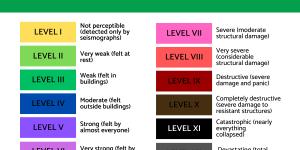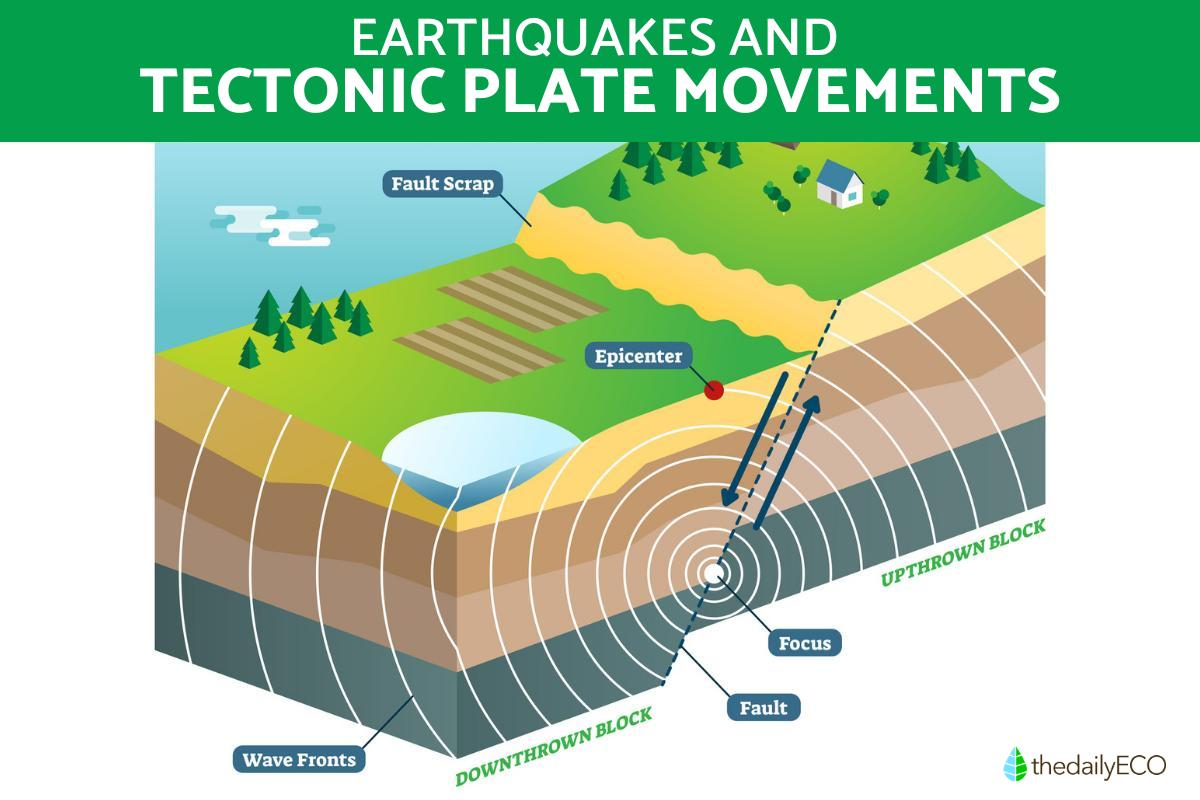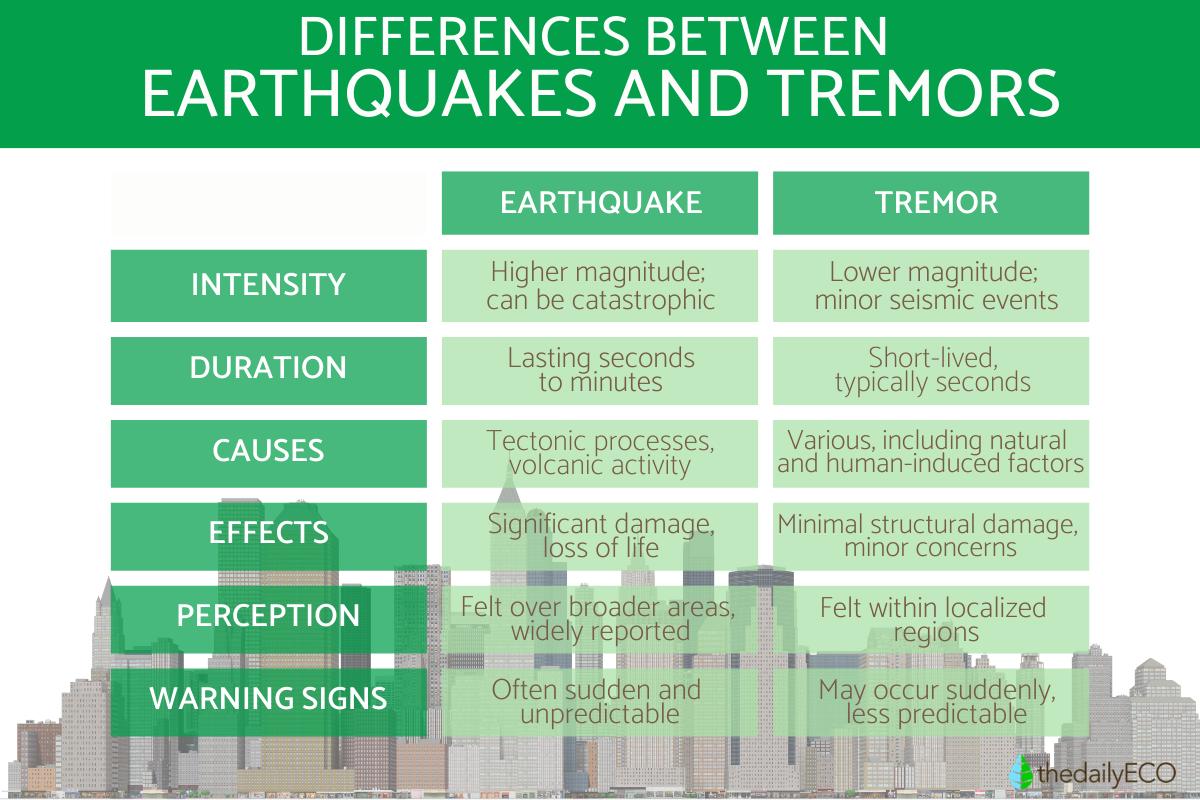What Is the Difference Between Earthquake and Tremor?


Earthquakes and tremors are natural geological phenomena that involve the shaking or movement of the Earth's surface. These events can trigger a sense of awe and curiosity, but it's essential to recognize that while these terms are frequently used interchangeably in everyday conversations, they each represent distinct seismic occurrences with their own unique characteristics and consequences.
The following article by thedailyECO explains the fundamental differences between earthquakes and tremors, shedding light on their causes, effects, and how they are measured.
What is an earthquake?
An earthquake is a sudden and often forceful shaking or trembling of the Earth's surface. This phenomenon results from the release of energy caused by the movement of tectonic plates along geological faults or from volcanic activity. As a consequence, seismic waves are generated and travel through the Earth, leading to ground vibrations.
The majority of earthquakes are closely linked to the interactions of Earth's tectonic plates, which compose the Earth's outer shell. These interactions mainly occur at plate boundaries, where several types of plate movements are observed:
- Divergent boundaries: Plates move away from each other, creating tensional forces that can lead to earthquakes.
- Convergent boundaries: Plates collide or move toward each other, generating compressional forces and often resulting in powerful earthquakes.
- Transform boundaries: Plates slide past each other horizontally, causing shear forces that can lead to earthquakes.
Apart from tectonic plate movements, earthquakes can be triggered by various other factors:
- Subduction zones: these zones arise when one tectonic plate is forced beneath another into the Earth's mantle, generating intense pressure and friction that can lead to significant earthquakes.
- Volcanic activity: volcanic eruptions can induce earthquakes as molten rock (magma) rises and interacts with surrounding rocks. The movement and pressure associated with volcanic activity can trigger seismic events.
- Faults: faults represent fractures or zones of weakness in the Earth's crust where rocks have shifted relative to each other. Sudden movement along a fault, known as a fault slip, can release stored energy, causing an earthquake.
- Isostatic rebound: after the melting of large glaciers, the Earth's crust may slowly rebound or rise back to its natural state. This process can result in earthquakes, although they tend to be of lower magnitude.
Be sure to read this other article that explores how are mountains created.

How are earthquakes categorized?
Earthquakes are a natural geological occurrence and can vary greatly in magnitude, ranging from minor, imperceptible tremors to catastrophic events capable of causing widespread destruction and loss of life.
Historically, earthquakes were primarily measured using the Richter scale, a groundbreaking system developed by Charles F. Richter in collaboration with Beno Gutenberg in 1935. However, this scale had its limitations, as it was primarily designed to assess earthquakes with magnitudes ranging from 3 to 7. When it came to larger seismic events, the Richter scale struggled to provide accurate readings, often underestimating their magnitude.
To address these shortcomings and provide a more precise and versatile method of measuring earthquake magnitude, seismologists introduced the moment magnitude scale (Mw) in the late 20th century. The Mw scale calculates earthquake magnitude by considering crucial seismic factors such as fault length, slip, and rock rigidity.
The moment magnitude scale, denoted as Mw, is a logarithmic scale, akin to the Richter scale. It quantifies the energy released by an earthquake. Each whole-number increase on the Mw scale corresponds to a tenfold increase in the amplitude of seismic waves and roughly 31.6 times more energy release.
These following categories provide a convenient way to understand and communicate the relative impact and potential danger associated with different magnitudes of earthquakes:
- Minor Earthquakes (Mw < 3.0): typically go unnoticed by people and rarely produce noticeable effects.
- Light Earthquakes (3.0 ≤ Mw < 4.0): are often felt by individuals near the epicenter, but seldom cause significant damage.
- Moderate Earthquakes (4.0 ≤ Mw < 6.0): can potentially damage poorly constructed buildings, but usually don't result in widespread destruction.
- Strong Earthquakes (6.0 ≤ Mw < 7.0): have the capacity to cause considerable damage over a substantial area.
- Major Earthquakes (7.0 ≤ Mw < 8.0): can lead to severe destruction across large regions.
- Great Earthquakes (Mw ≥ 8.0): are capable of causing catastrophic devastation over extensive areas.
Keep in mind that the actual effects of an earthquake can also depend on other factors such as depth, distance from the epicenter, local geology, and building infrastructure.
What is a tremor?
A tremor can be defined as a gentle, rhythmic shaking or vibration of the Earth's surface. Tremors are typically characterized by their lower magnitude and shorter duration when compared to more significant seismic events such as earthquakes.
It's essential to note that tremors are generally not powerful enough to cause significant structural damage or pose a substantial threat to human safety. However, they can be noticeable to people in the affected area, leading to minor concerns such as windows rattling, objects swaying, or a subtle sensation of ground movement.
At what point does a tremor become an earthquake?
There is a common misconception that suggests tremors always precede earthquakes. However, this is not entirely accurate. Earthquakes can happen abruptly and without any warning signs. While there have been instances where foreshocks (smaller earthquakes preceding a larger one) have been observed, they do not consistently serve as a reliable indicator of an impending major earthquake.
How are tremors categorized?
In the moment magnitude scale (Mw), the classification of seismic events as "tremors" is not explicitly defined by a specific magnitude range, as it can vary depending on local definitions and the context in which the term is used. As such, both Richter scales and moment magnitude scales are designed to provide precise measurements of earthquake magnitude and do not distinguish distinct categories such as "tremor." Nonetheless, the term is commonly used informally to describe seismic events of relatively low magnitude and intensity.
What magnitude is considered a tremor?
Tremors may register on the lower end of the magnitude scale, typically below 3.0 Mw, but again, this can vary. There is no universally accepted magnitude threshold that defines when a seismic event is classified as an earthquake versus a tremor, and this classification may vary depending on local definitions and practices.
Furthermore, a tremor's intensity can also be affected by factors such as the depth of the earthquake's focus (shallow earthquakes may feel stronger than deep ones), the distance from the epicenter, and local geological conditions.

Differences between earthquakes and tremors
The terms "tremor" and "earthquake" are not synonymous, but are sometimes used interchangeably in casual conversation. Let us take a closer look at some of their most important differences:
Magnitude
- Earthquakes: are more significant seismic events characterized by a higher magnitude on the Richter or moment magnitude scale. They can range from minor to catastrophic in terms of intensity.
- Tremors: are relatively mild and have a lower magnitude compared to earthquakes. They are typically not as intense and are considered minor seismic events.
Duration
- Earthquakes: can last for an extended period, often ranging from seconds to minutes, depending on their magnitude.
- Tremors: are relatively short-lived events, typically lasting for a few seconds to a minute or so.
Causes
- Earthquakes: are primarily caused by the sudden release of energy along geological faults, volcanic activity, or other tectonic processes.
- Tremors: can have various causes, including natural factors like volcanic activity, groundwater movement, or minor fault movements, as well as human-induced activities like construction or mining.
Effects
- Earthquakes: can result in significant structural damage, loss of life, and widespread destruction. They can trigger secondary events like tsunamis and landslides.
- Tremors: are generally not strong enough to cause significant structural damage or pose a substantial threat to human safety. They may lead to minor concerns such as rattling windows and swaying objects.
Warning signs
- Earthquakes: can occur suddenly and without warning, making them challenging to predict. Foreshocks (smaller earthquakes before a larger one) are not always reliable indicators of a major earthquake.
- Tremors: can also happen without warning, but they are less likely to be associated with foreshocks.
Perception
- Earthquakes: are often felt over a broader geographical area and are more likely to be widely reported.
- Tremors: are typically felt within a localized region and may not be widely noticed or reported.
Scientific measurement
- Earthquakes: are precisely measured using seismometers, and their magnitude is recorded on the Richter or moment magnitude scale.
- Tremors: are also measured with seismometers but are associated with lower magnitudes.
To gain a better understanding of various geological processes, such as volcanoes, delve into our article that explains the causes behind a volcano's eruption.
If you want to read similar articles to What Is the Difference Between Earthquake and Tremor?, we recommend you visit our Facts about nature category.







